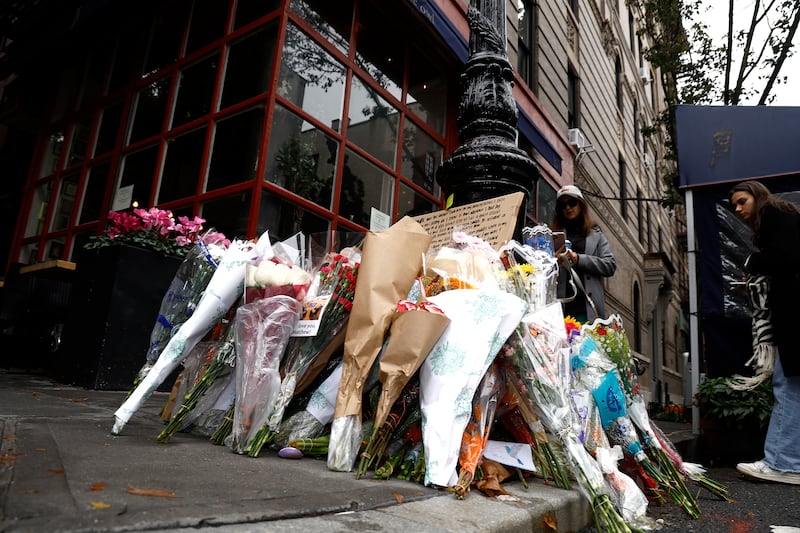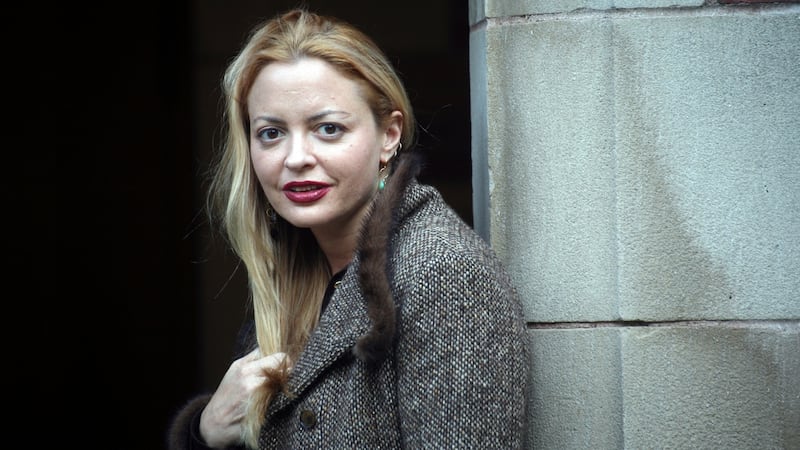When news broke of the death of Matthew Perry last weekend, fans and mourners gathered in lower Manhattan on a dismal Sunday, to lay flowers and sympathy notes outside the building, which features as the exterior scene-setter for that iconic apartment in Friends. There is, of course, a sweet irony in the public gathering at the fictive home of Perry’s most famous acting creation, Chandler Bing. With the five other actors whose public lives have been defined by the phenomenal and enduring popularity of a sitcom that will soon celebrate its 30th anniversary, Perry had long accepted that his alter-ego would outlive him.
“When I die, I know people will talk about Friends, Friends, Friends,” he said last year. “And I’m glad of that, happy I’ve done some solid work as an actor, as well as given people multiple chances to make fun of my struggles, on the world wide web...
“But when I die, as far as my so-called accomplishments go, it would be nice if Friends were listed far behind the things I did to try to help other people. I know it won’t happen, but it would be nice.”
He may have been wrong on that one. In the days since, along with the tributes to the actor’s unique comic sensibility and delivery, have come a deluge of tributes to the small kindnesses he visited on others. Perry’s death, after an apparent drowning in his hot tub, stands as the lonely full-stop on a turbulent public life in which vast wealth compensated for little. “Well, last week I bought Iowa,” he deadpanned, when asked if the royalties from Friends were still considerable.
READ MORE
But his self-lacerating and funny memoir, Friends, Lovers and the Big Terrible Thing, published last year, stands as a smart and painfully honest portrait of the treacheries of celebrity life and the relentless force of alcoholism. Perry’s death will probably see a spike in book sales this week. And it has again turned the spotlight on the stubborn refusal of Friends to recede from either the screen or the general imagination.
Instead, it stands as an unlikely lodestone for the increasingly idealised decade, the 1990s. Nostalgia for “that time” is running amok. Those old enough to remember are gazing back at the twilight of the millennium with increasing wistfulness and those not even born then – ask any teenager – will declare with candour that they wish they could have been there. For whatever reason, to many, the 1990s look like fun from where we find ourselves now. And Friends, now streaming on Netflix, is one of those reasons, even if the secret to its longevity is difficult to pin down.
“Friends was easy TV at an elite level,” wrote Wesley Morris in a terrific New York Times piece grappling with the appeal of the show as it hit the 25-year mark. “So many jokes, so much body comedy, so many surprises and squeals of live-studio audience excitement. Hairdressers were doing – and not infrequently botching – the Rachel. Coffee shops became people’s second home. Tens of millions of Americans watched all of that writing and directing and acting, all of that seemingly effortless effort, for all 10 of its years. That work and a country’s devotion to it feels like proof of a golden age of something.”
But a golden age of what? Friends made its debut appearance in 1994, the same year as Kurt Cobain died; as the film Reality Bites – starring and directed by Ben Stiller – was released; as Jeff Buckley’s Grace was first heard. The first episode aired in September, the same month that 26-year-old Elizabeth Wurtzel’s memoir Prozac Nation: Young and Depressed in America caused a storm. Wurtzel had grown up in New York in the 1970s and 1980s, when, during “the [mayor] Abe Beame years you could buy a three-bedroom apartment on Columbus Avenue for $15,000 and worry that you were getting ripped off”.

The world and stars of Friends were completely cocooned from that grungy aesthetic and real-life problems. The show was set in the New York of the 1990s but never quite tethered to it. Instead, it was tethered to a cushiony, unthreatening NYC fantasia. There is nary a mention of world affairs or anything besides the trifling preoccupations and tangled love lives of the six. Nearly 30 years on, it leaves itself increasingly open to myriad criticisms of homophobia, transphobia, body-shaming and the willful whiteness of its casting. And there is a healthy army of Friends-haters, who cannot believe that these six narcissistic, spoiled, judge-y whiners are now feted as the triumph of television sitcom history.
In February 2001, Janet Yellen, the former economic adviser to President Bill Clinton, wrote a book about the economics of the 1990s. She called it The Fabulous Decade. That title seemed apt. Those 10 years closed out the monumentally violent 20th century in a blazing sunset. The Cold War was over. Clintonian optimism reigned supreme; the economy was booming. New York, after the fear and dread and bankruptcy, was thriving. Friends tapped into that vibe. And it also straddled the city’s experience before and after the September 11th attacks. The Twin Towers had been part of the show’s opening shots. The event was never explicitly mentioned in the show because by then, escapism had become and remains its core attraction. As Perry noted, it had the power to bring distinct generations of viewers together.
The very last scene in the last episode of Friends has the six heroes exiting the apartment, leaving their keys on the counter. It’s a tear-jerker. By then, the identities of the actors and their characters had become so blurred that its global audience knew that the finale held a double edge. By leaving the apartment for the last time, “Rachel” had to get on with the real-life business of being Jennifer Aniston, “Ross” had to settle for being David Schwimmer and so on. They’d be fine: it was obvious that Matthew Perry would find that terrain the roughest. But they had no choice but to go. They had grown up.

Years after the showbiz set had forgotten about her, Elizabeth Wurtzel wrote a series of glittering, brilliant essays about what had become of her. One of those – Elizabeth Wurtzel Confronts Her One Night Stand of A Life – published in New York Magazine in January 2013, is one of the very best things you could hope to read on the city. Unlike the six Friends, Wurtzel did not turn in her key, quit the apartment and move on to the next stage. “I had refused to grow up,” she wrote. “I was becoming one of those people who refuses to grow up – one of the city’s Lost Boys. I was still subletting in Greenwich Village, instead of owning in Brooklyn Heights.”
Instead, she continued to battle through addictions, relationships, graduated from Yale with a law degree (”Any fool can be a lawyer. It’s really hard to be a writer.”) and stared down her accelerating 40s with nothing like the security she might have opted for. It’s an essay about the passing of time and the choices one makes. But it also bottles the feel of her city during the last decade of the old century – and it also offers a possible explanation as to why Friends has travelled unassailably through the decades since.
“Soon New York will be nothing but a metropolis of the very rich and those who serve them – and the lucky and desperate still hanging on. All of the fun jobs are disappearing.”
— Elizabeth Wurtzel
Wurtzel, a fifth-generation Manhattanite, was born in 1967, two years before Perry. She died, of breast cancer, in 2020, aged 52. In the early 1990s, she lived in a Manhattan teeming with artists, creative people, public intellectual academics, political thinkers: those who make a city vital and fun. “But these are people who soon won’t exist anymore,” she warned.
“Soon New York will be nothing but a metropolis of the very rich and those who serve them – and the lucky and desperate still hanging on. All of the fun jobs are disappearing.”
This is the New York that Friends, despite the unlikely opulence of that apartment, reflected in its hokey way. They were of the last generation of 20-somethings not robbed of their independence by the property heists and rental abominations that have made the modest hope of a reasonable life out of reach for the young in so many cities. They have jobs rather than gigs. They have time to make mistakes. No wonder Friends represents such a visual fantasy now.
And for all its flaws and irritations, Friends at least made a sincere stab at exploring the concept of friendship. For 10 years, the gang moved between apartment and coffee shop in various groupings but sooner or later, all six would gather. They spoke, face to face, all the time. There were no distractions. And, of course, there were no phones. Scan any coffee shop now and we all have our faces glued to our screens. And their blithe indifference to the outside world was, in its own way, a collective strength. The conceit of Friends was that once together, the outside world did not matter; that they somehow protected one another from it. And tens of millions of viewers have enjoyed leaping into that space for the 22-minute chunks of escapism. They still do.
At the close of that luminous essay, Elizabeth Wurtzel made this observation:
“Look at how we live: We communicate in text messages and emails; even those of us old enough to have lived in a world where landline was not a word because it’s all there was have fallen into this lazy substitute for human contact. I have. When I was young, when I was the age, I should have been when all this happened, if I needed to tell a friend, an acquaintance, or the customer service person from AT&T the smallest thing, I had to talk to him. Every day, many times a day, whether I felt like it or not, I spoke to people, lots of people. Now, in a whole long day of croissants in the morning and multiple dog walks and stops at the bodega for yogurt and jam, I may speak with people I care about only in type. When you add the mistakes of Facebook and Twitter into this equation, very bad things can happen. The illusion of friendship defeats the real thing. Someone who people believe they care about and cannot live without could end up dead.”











